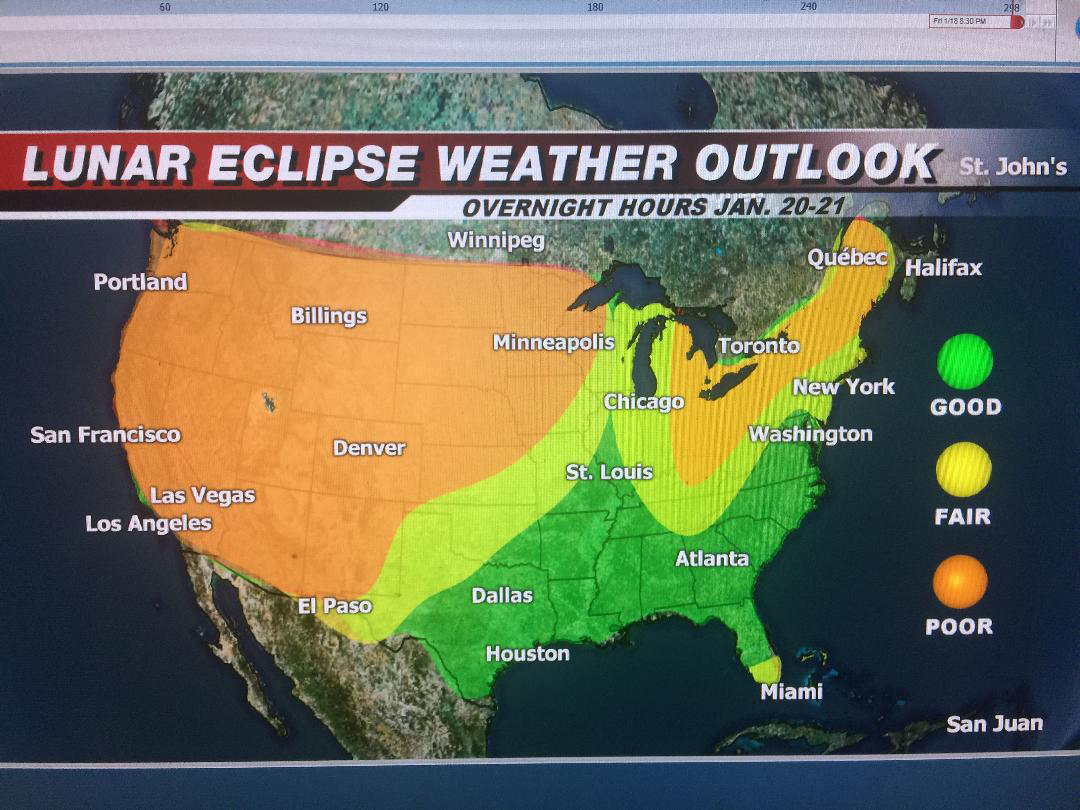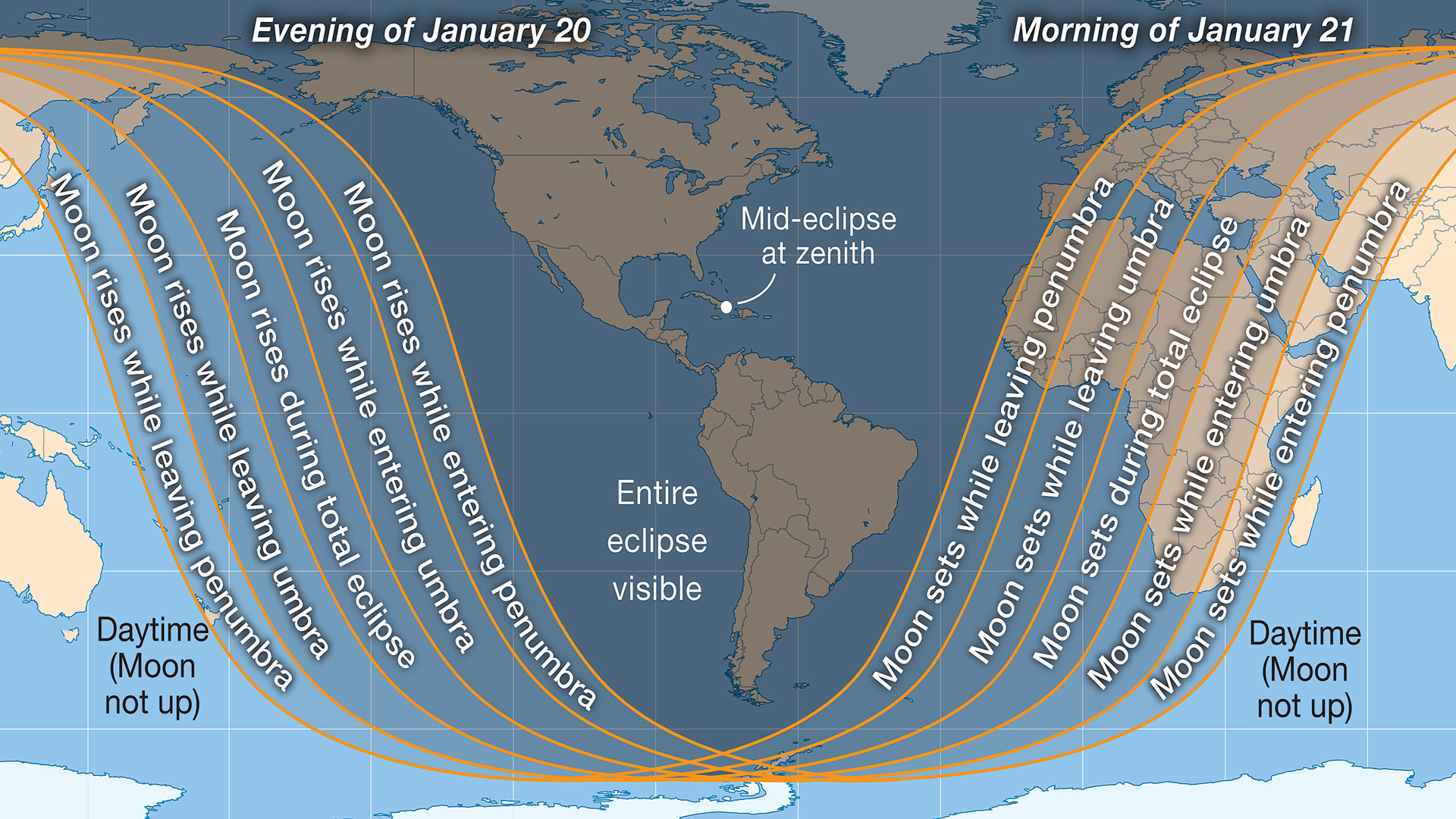Here's the Weather Forecast for the Super Blood Wolf Moon of 2019 Tonight!
Update for 3 a.m. EST, Jan. 21: The total lunar eclipse of 2019 has ended. See our full story here! See more photos here!
It's time for the total lunar eclipse of 2019 and if you're hoping to catch the amazing event, you better check your weather first. The National Weather Forecast for the lunar eclipse tonight (Jan. 20) is basically a coin toss for depending upon where you plan to be.
It appears that about half of the United States will have clear skies which will provide a good backdrop for observing tonight's total lunar eclipse. For the rest of the nation, cloudiness will vary in degree from providing occasional views of the darkening moon to in other cases a complete shutout from viewing the sky show. Check out the weather map below to see what your conditions might be like. If bad weather prevents a live view, you can watch webcasts of the Super Blood Wolf Moon eclipse online. One webcast from Slooh.com will be simulcast on Space.com beginning at 10:30 p.m. EST (0330 GMT).
The best views can be found over the Piedmont and the Southeast U.S. coast, including Florida and much of the Deep South, as well as central and eastern Texas and a slice of the central Great Plains, where mainly clear weather is anticipated. [Super Blood Wolf Moon Eclipse of 2019: Complete Guide]

In the Eastern U.S., a major winter storm will be spinning just off the New England coast. Widespread cloudiness associated with this system will cover much of central and northern New England, as well upstate New York and parts of the Great Ohio Valley and the eastern Great Lakes.
However, a slot of drier and clearing skies will be progressing through the heavily populated "Northeast Corridor," giving viewers in Washington, Philadelphia, New York, Providence and Boston hope of getting a view of tonight's free sky show through retreating clouds. [How to Photograph the Super Blood Wolf Moon!]

One drawback for eclipse watchers in the Middle Atlantic and Northeast States will be the blustery, bitter winds and extreme cold that will be settling in behind the New England storm. In many locations at eclipse time the ambient air temperatures will be falling rapidly through the teens and single digits, while wind chill/feels like temperatures, will be in the subzero range. This will make for a rather uncomfortable situation, even if the sky is clear. John Bortle, a well-known and highly respected celestial observer of comets and other sky objects is not looking forward to braving the frigid elements. He writes:
Get the Space.com Newsletter
Breaking space news, the latest updates on rocket launches, skywatching events and more!
"The prevailing conditions will hardly be conducive to hanging around outside and observing. Each forecast I watch seems to anticipate a lower temperature figure! The latest temperature range for my area is running close to zero degrees. At anything close to that cameras cease to operate and so do observers my age. That, plus the wind here is forecast to gust at 35-45 mph! YUCK!"
Mr. Bortle adds: "The eclipse could prove an event far more memorable for the prevailing weather conditions than the eclipse itself."
Out West, a series of storms from the Pacific, will produce a large swath of broken-to-overcast skies that will cover much of California, the Pacific Northwest, the Rocky Mountains, Southwest Desert and the Northern and Central Great Plains, unfortunately denying a view of the eclipse for tens of millions of people.
To obtain the latest weather forecast, tailored specifically for your hometown, check this National Weather Service website: http://www.nws.noaa.gov/organization.php
You will find links to National Weather Service Forecast Offices across the United States, as well for Puerto Rico and American Samoa. Just locate your region and click on the weather office nearest to your location; you be able to get the latest weather outlook.
Where you plan to be, good luck and clear skies!
Editor's note: If you snap an amazing photo of the January 2019 total lunar eclipse that you'd like to share with Space.com and our news partners for a possible story or image gallery, send comments and images in to: spacephotos@space.com.
Join our Space Forums to keep talking space on the latest missions, night sky and more! And if you have a news tip, correction or comment, let us know at: community@space.com.

Joe Rao is Space.com's skywatching columnist, as well as a veteran meteorologist and eclipse chaser who also serves as an instructor and guest lecturer at New York's Hayden Planetarium. He writes about astronomy for Natural History magazine, Sky & Telescope and other publications. Joe is an 8-time Emmy-nominated meteorologist who served the Putnam Valley region of New York for over 21 years. You can find him on Twitter and YouTube tracking lunar and solar eclipses, meteor showers and more. To find out Joe's latest project, visit him on Twitter.









